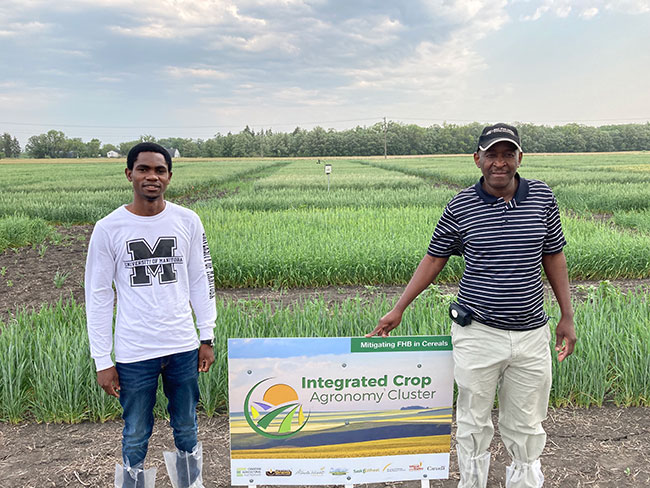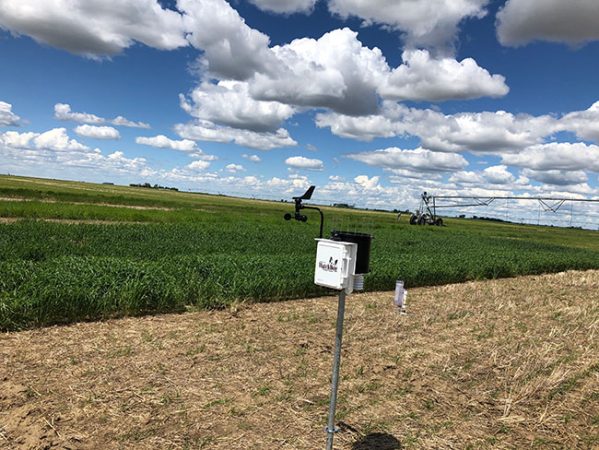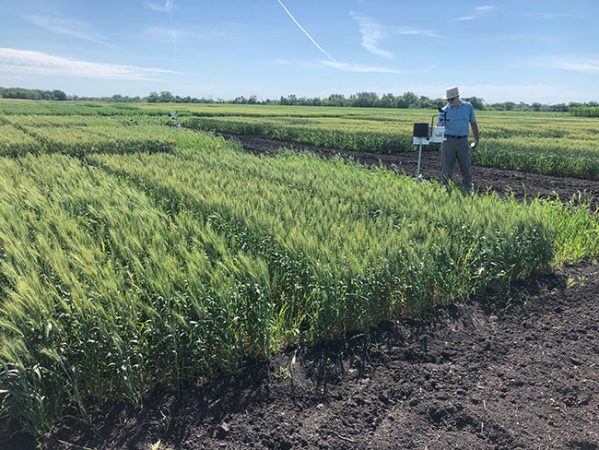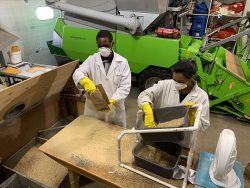
Features
Diseases
A new risk model for Fusarium head blight
Using a weather-based model to assesses infection and risk of FHB and FDK in Prairie cereal crops.
May 18, 2022 By Donna Fleury
 Taurai Matengu, masters’ student, and Manasah
Mkhabela, project manager, at the Kelburn plot site. Photo courtesy of Paul Bullock.
Taurai Matengu, masters’ student, and Manasah
Mkhabela, project manager, at the Kelburn plot site. Photo courtesy of Paul Bullock. Fusarium head blight (FHB) is the most serious fungal disease affecting wheat and other cereals in Western Canada and most cropping areas of the world. Growing cereals with higher FHB resistance ratings and the application of a proper fungicide near the time of anthesis can help producers lower the risk of FHB. Fungicide can reduce losses in yield, grade as a result of Fusarium-damaged kernels (FDK) and mycotoxin infection such as deoxynivalenol (DON) when weather conditions favour FHB development, the crop is susceptible and Fusarium species are present in significant quantities. However, research has shown that fungicide application does not always provide a tangible benefit, so researchers are working on developing tools to improve risk assessment of FHB and reduce uncertainty about the value of fungicide applications.
At the University of Manitoba, researchers are leading the development of a new risk model and a FHB/FDK/DON risk-mapping tool. The goal of the project is to enable producers to make more informed decisions about when fungicides are necessary, providing significant financial benefits and reducing potential environmental side effects if application is not needed. One of the key project objectives is to develop weather-based models to assess the risk of FHB infection, FDK and DON in spring wheat, winter wheat, barley and durum crops with different FHB resistance ratings. A second objective is to develop an interactive Prairie-wide viewer and FHB/FDK/DON risk-mapping tool that shows the risk levels in real-time and is accessible to producers and industry to assist with fungicide application decisions.
“There are three main aspects to this five-year project, including an intensive plot study, producer field sampling and development of an online tool. The intensive plot study is providing the foundation for the project, with 15 plots across Western Canada, five in each of Alberta, Saskatchewan and Manitoba, for three different growing seasons,” explains Paul Bullock, soil science researcher at the University of Manitoba. “The project is pan-provincial, which is one of its unique aspects. It has very strong support from all three Prairie provinces. Although the provinces have individual FHB modelling capability, the models they use are all different. Therefore, this project provides an opportunity to develop a common model that can be utilized across the Prairies.”
At each plot study site, three varieties of spring wheat, winter wheat and barley with different FHB resistance ratings of resistant/moderately resistant, intermediate or susceptible/moderately susceptible, and one variety of durum wheat were grown for all three field seasons. Individual portable weather stations were set up in each of the 15 locations to provide intensive weather data for model development. The weather stations were all calibrated at the same time each spring before being moved to their locations. At most locations, there was also an Environment Canada weather station nearby as a backup. Spore traps were installed at each location mid-season to confirm if Fusarium spores that cause the disease were present at the time of flowering. The project included very intensive plot data collection critical for developing the models, such as plant density, growth stages, spore counts, FHB infection rates and grain yield. After harvest, grain samples from each plot were submitted to a commercial lab in Winnipeg for grading for an official Canadian Grain Commission grade and measures of per cent Fusarium Damaged Kernels (FDK) and deoxynivalenol (DON) mycotoxin levels to help quantify the Fusarium damage in the plots.

One of the Alberta FHB plot sites with irrigation equipment in the background and the project weather station in the foreground. Photo courtesy of Taurai Matengu.
“The intensive data collection is critical for providing good solid information to build these models, and it is the most resource intensive part of the project,” Bullock says. “We know that FHB infection happens mainly at anthesis or flowering in cereals, so determining the timeframe when the heads are at the most vulnerable point for infection to occur is very important for estimating risk and determining if fungicide applications would be needed. Since not all cereal plant heads flower at the same time, we needed to identify a date of mid-flowering or 50 per cent anthesis. We collected crop growth stage data every week, and although we couldn’t go into the plots daily, this information allows us to use a modelling approach to interpolate the anthesis date based on a combination of observed growth stage and heat units accumulated each day. At three weeks after anthesis, 50 heads were collected from every plot to determine the number of spikelets infected by FHB in each plot and to calculate the FHB index. We used almost a hundred different weather variables including temperature, rainfall, relative humidity, and combinations of these for different time periods prior to anthesis and after anthesis to develop the best logistic regression model that matches what we are seeing in the plots.”
The second component of the study included sampling of more than 100 producer fields across the Prairies every year for three years to mirror the data collected in the intensive plots. In each province, the provincial agriculture specialists made the connections with collaborating producers, and the project provided a summer student in each province to work with the specialists and producers. The producers left a 30-by-30-metre area within their field that did not have a fungicide application. The same plant growth stages, spore counts and grain yield data were collected in each field as was done in the intensive plots. To gather weather data, the GPS coordinates for each field were used to identify the closest weather station to characterize the weather conditions in the period prior to anthesis. The FHB infection rates and index were calculated using the same protocols of collecting 50 heads from within the unsprayed check area. Just prior to harvest, whole plant samples were collected, dried and grain samples threshed out to be sent to the commercial lab for grading, FDK and DON assessments.
“We collected as much good quality data as we could from the producers’ fields for three years. The analysis of the field samples from 2021 are just about finished going through the analysis pipeline. We are using the producer field data to test the models developed using the intensive plot data to see how well those models are working. This will provide confidence that the plot-based models are just as accurate when used for commercial field assessments. Based on the first two years of data, the answer is “yes” the models seem to work reasonably well at predicting the risk of FHB, FDK and DON in producer field cereal crops. We recognize that growing conditions were fairly dry over the three years that the plot and producer field data were collected and we saw a limited number of epidemic cases of FHB. However, the results so far are very encouraging, we believe the models work well. Like all robust modelling tools, continuing to collect and add data to the models under different growing conditions will be essential to ensuring their accuracy in the long-term.”

Paul Bullock checking the weather station at the Kelburn Farm plot site south of Winnipeg.
Photo courtesy of Taurai Mategu.
The last component of the project, just getting underway, is to develop an interactive Prairie-wide viewer and FHB/FDK/DON risk-mapping tool that is accessible to producers and industry to assist with fungicide application decisions. The company contracted to develop the tool has completed the initial design and started building the tool. “The tool is designed to access weather data for the Prairies in real-time from provincial weather networks plus every Environment Canada weather station in the cropping areas. The tool will run the weather data through the model algorithms to compute a risk probability at every weather station. None of the weather data is made public in the system being developed, it is only used to create a risk value on specific dates for FHB infection. The tool will calculate risk levels for each crop and resistance
category at each weather station, and those point values will be used to map interpolated risk levels in the areas between stations. The online tool will provide regional scale risk levels and will not have sufficient resolution for individual fields. However, farmers will be able to customize the risk assessment they receive from the tool by selecting a specific area as well as a specific crop and variety to generate a map showing the FHB risk that reflects their specific circumstances.”

Masters’ students Taurai Mategu (left) and Sachithrani Kannangara winnowing grain that was threshed from the
harvested plants collected in producer fields. Photo courtesy of Paul Bullock.
The risk maps will help identify which areas are at higher or lower risk for FHB, and alert producers where field scouting will be important for determining if spraying a fungicide is warranted. The FHB/FDK/DON risk-mapping tool will enable producers to make more informed decisions about when fungicides are necessary, protecting crops when needed or reducing costs and unnecessary pesticide application if not needed. Overall it provides a more targeted and effective management tool for reducing FHB and DON, with a significant financial benefit.
“Building successful projects takes time, and so far we have developed a great team and process for collecting the data and developing the model,” Bullock says. “The model and online tool will be ready for further testing during the 2022 crop season. When the project wraps up at the end of 2023, we expect to have a functional online system in place for FHB risk assessment from Prairie weather station networks. But, it is important to recognize the need for regular annual data collection going forward to build a more extensive and robust database that will provide higher accuracy and reliability of the models as well as keep up to date with changing disease levels and growing season weather condition.”